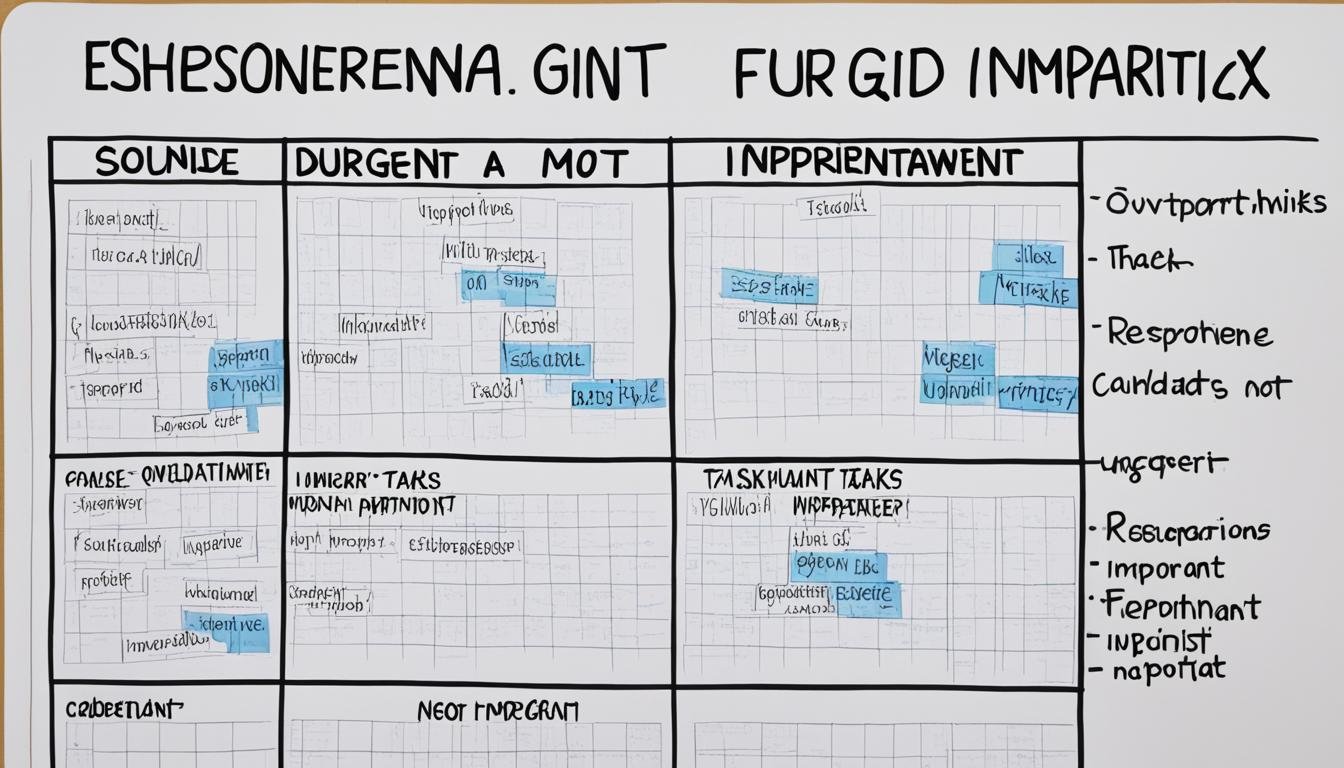Highly productive people have habits and strategies that help them work better and beat common challenges. By looking at their ways, we can pick up valuable tips to boost our efficiency. These tips can help us do more in less time, whether you’re busy at work, studying, or just trying to manage your day better.
Key Takeaways:
- Focus on the most important tasks first.
- Cultivate deep work for enhanced concentration and focus.
- Keep a distraction list to minimize interruptions.
- Utilize the Eisenhower Matrix to prioritize long-term goals.
- Apply the 80/20 rule to identify the most impactful activities.
Focus on the Most Important Tasks First
Highly productive people focus on the most important tasks first. This is known as Most Important Tasks (MITs). Doing so ensures they work on the most impactful tasks early. This keeps them efficient and productive all day.
By prioritizing tasks, people can make a meaningful to-do list. This way, the important tasks get done. Giving priority to tasks that help reach goals leads to significant work progress and desired outcomes.
Time management and productivity improve when the most important tasks are done early. The brain is most alert and focused in the early morning. It’s the best time for complex and challenging tasks.
Starting with the most essential tasks helps avoid wasting time on less important activities. This boosts overall productivity. It makes time use more strategic, focusing on tasks that greatly impact progress and success.
Also, prioritizing tasks prevents feeling overwhelmed or scattered during the day. Breaking down crucial tasks into smaller steps makes them easier to handle. This improves focus, concentration, confidence, and motivation.
Benefits of Prioritizing Tasks:
- Efficiency: Focusing on key tasks optimizes time and resources, boosting efficiency.
- Productivity: Prioritizing tasks means more impactful work gets done, leading to better productivity and progress.
- Time Management: It helps manage time well, meeting deadlines and not missing important work.
- Prioritization: It helps identify the most critical activities, guiding decisions on resource use.
Cultivate Deep Work
Deep work is a key way to boost your productivity and focus. It means diving deep into a task without distractions. This helps you do high-quality work faster.
Not everyone finds deep work easy. It takes practice and effort to get better at it. Here are some tips to help you add deep work to your daily routine:
Create a Deep Work Schedule
It’s important to set aside time for deep work. Choose specific times when you won’t be interrupted. Pick a time that fits your schedule best and stick to it.
Embrace Boredom
Deep work means getting okay with feeling bored. Our world is always distracting us. By not giving in to distractions, you train your brain to focus better.
Minimize Distractions
It’s key to avoid distractions for deep work. Find out what distracts you the most and eliminate it. This could mean turning off your phone or using apps that block certain websites.
Understand Your Work Habits
Everyone works differently. Figure out what works for you. Some like total silence, others prefer music. Try different settings to find what helps you focus best.
Adding deep work to your routine lets you do more in less time. You’ll be more efficient and productive. This means you can consistently do your best work.

| Benefits of Deep Work | Techniques to Cultivate Deep Work |
|---|---|
| 1. Increased productivity | 1. Create a deep work schedule |
| 2. Enhanced focus and concentration | 2. Embrace boredom |
| 3. Higher quality work | 3. Minimize distractions |
| 4. Improved efficiency | 4. Understand your work habits |
| 5. Accomplish more meaningful tasks |
Keep a Distraction List to Stay Focused
Distractions can really slow us down. To fight this, many successful people use a technique called a distraction list. This means keeping a list close to write down any distracting thoughts or ideas that pop up while working. Writing them down helps you acknowledge these distractions without losing focus on your main task.
This way, you can deal with distractions during breaks or add them to your to-do list later. It helps you stay on track.
The Power of a Distraction List
A distraction list is like a mental note-taking system. It lets you catch random thoughts and ideas without losing your focus. It’s a great way to manage distractions and keep your main tasks in sight.
“The distraction list is a simple yet powerful tool that allows us to acknowledge distractions without letting them consume our attention and energy.” – Jane Smith, Productivity Expert
It’s simple to make a distraction list. Just have a notepad or digital document open while you work. When a distracting thought comes up, write it down. This way, you give it a spot, so you can come back to it later without losing your train of thought.
- Boost efficiency: Having a distraction list helps you avoid constantly switching tasks, making you more efficient in your work.
- Increase productivity: By focusing on one task at a time, you finish tasks faster and get more done each day.
- Minimize mental clutter: Clearing your mind of distractions lets you focus better and think more deeply.
Check your distraction list during breaks or at the end of the day. This helps you handle any distractions and see if they need action now or can wait for your to-do list.
| Distraction | Action Needed |
|---|---|
| Phone notifications | Silence phone during work hours |
| Meeting reminder | Prepare agenda and materials in advance |
| Social media urge | Allocate 10 minutes for social media breaks |
With a distraction list, staying focused is easier. You can prioritize your tasks better, making you more efficient and productive overall.
Use the Eisenhower Matrix to Identify Long-Term Priorities
Managing your time well means putting things in order. The Eisenhower Matrix, made famous by Stephen Covey, is a great tool for this. It helps you spot what’s important for the long run and use your time wisely.
This matrix sorts tasks into four groups: urgent and important, important but not urgent, urgent but not important, and not important or urgent. This way, you know what to do first and what you can skip or give to others.
Using the Eisenhower Matrix boosts your efficiency and productivity. It helps you focus on tasks that match your goals and have a big impact over time. Here’s how it works:

- Important and urgent: These tasks need your attention right away. They’re often tied to deadlines or key for your work or life.
- Important but not urgent: These tasks are crucial for your long-term success but aren’t pressing. Setting aside time for them helps avoid them becoming urgent later.
- Urgent but not important: These tasks might be urgent, but they don’t really help your long-term goals. Think about passing them on or dropping them to focus on more critical tasks.
- Neither important nor urgent: These tasks are often just a waste of time and don’t help your productivity or goals. Don’t spend too much time on them.
By checking and using the Eisenhower Matrix often, you stay on track with what’s important. It helps you manage your time better and boosts your productivity. Putting tasks in order by their importance and urgency lets you use your time and energy well. This way, you move closer to your long-term goals.
Use the 80/20 Rule
Highly productive people know the 80/20 rule, also known as the Pareto Principle. It says 80% of results come from just 20% of efforts. By using this rule, they make their work more efficient and productive.
They find the most important 20% of their work and focus on it. This means they spend more time and resources on these tasks. This strategy helps them work smarter and achieve more by focusing on what’s important.
This idea works in many areas, like work, personal projects, and making decisions. By finding the key areas that make the biggest difference, people can work smarter and make better choices.
For instance, a sales person might focus on the 20% of clients that bring in 80% of their sales. By focusing on these key clients, they use their time and resources better, leading to more sales and efficiency.
Examples of the 80/20 Rule in Action:
- A project manager who finds the 20% of tasks that make 80% of the project successful and focuses on them.
- A business owner who sees the 20% of products or services that make 80% of their revenue and works on those.
- A student who finds the 20% of study materials that cover 80% of the exam and uses their time wisely to prepare.
To use the 80/20 rule well, it’s important to keep checking and adjusting your priorities. Regularly look at tasks, projects, and goals to make sure you’re using your time and resources right.
The 80/20 rule is a great way to get more efficient, productive, and focused. By focusing on the most important tasks, you can make the most of your efforts and get great results.
Conclusion
Highly productive people have habits and strategies that can help you lead a more productive life. By prioritizing tasks and focusing on what’s important, you can boost your efficiency. Techniques like deep work and the 80/20 rule are great for improving your performance.
Using these strategies helps you streamline your tasks and avoid wasting time. This way, you can focus on what really matters. You’ll see your efficiency and performance go up in both your personal and work life.
By always looking to get better and using these tips, you can reach your goals and live a fulfilling life. Embrace the idea of being efficient and productive to unlock new success. Make every moment count and reach your full potential.
FAQ
What are some efficiency tips for a more productive life?
How can I focus on the most important tasks first?
What is deep work and how does it improve productivity?
How can I stay focused and minimize distractions?
What is the Eisenhower Matrix and how can it help with prioritization?
How does the 80/20 rule enhance productivity?
Source Links
- https://www.activecampaign.com/blog/habits-of-highly-productive-people
- https://www.today.com/life/inspiration/how-to-be-more-productive-rcna64127
- https://www.simplilearn.com/how-to-be-more-productive-article







GIPHY App Key not set. Please check settings